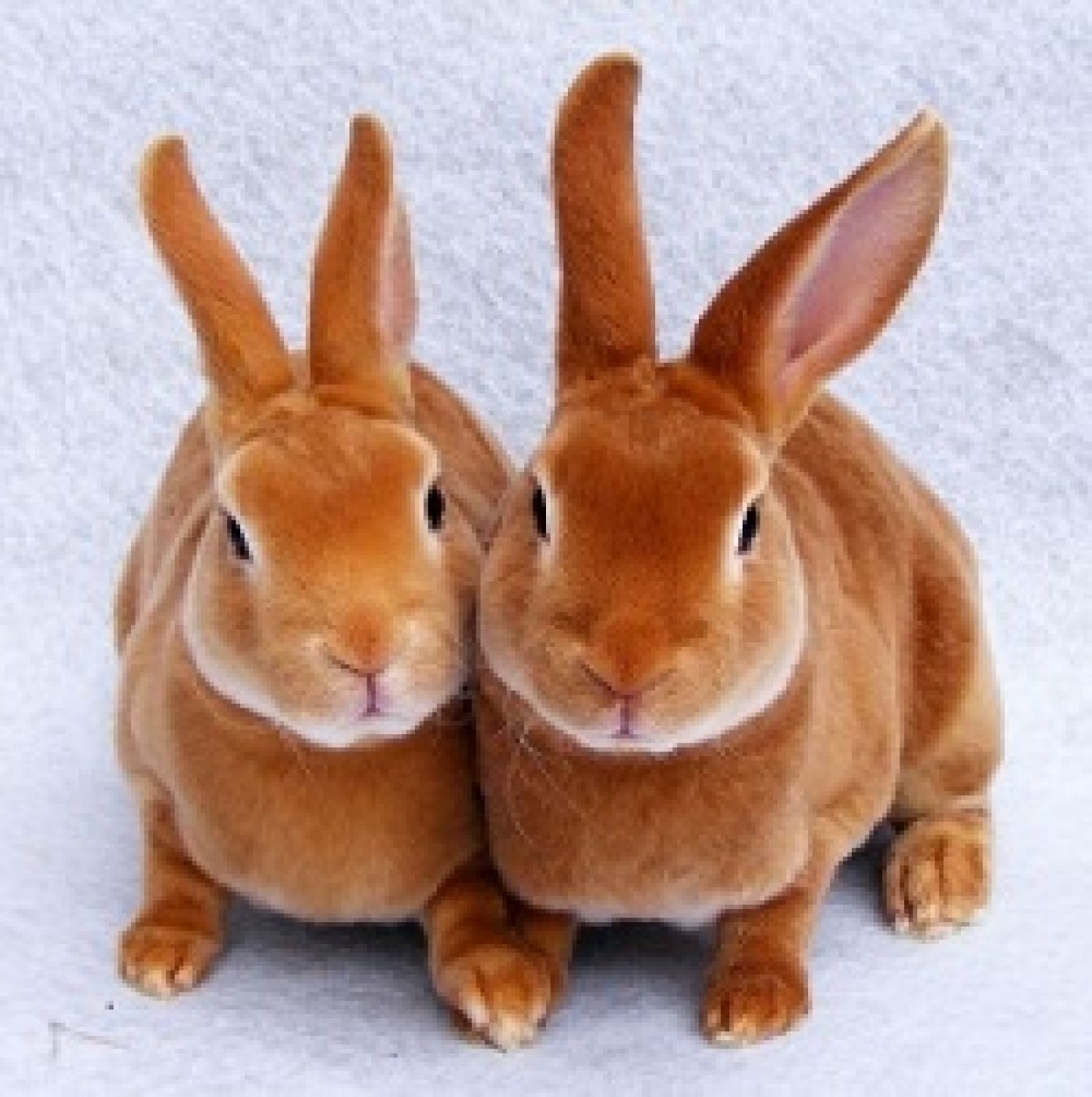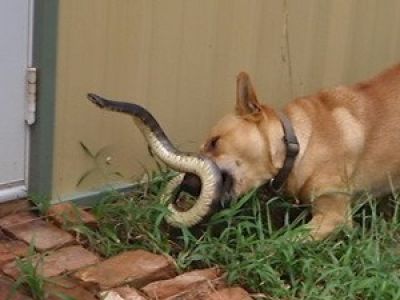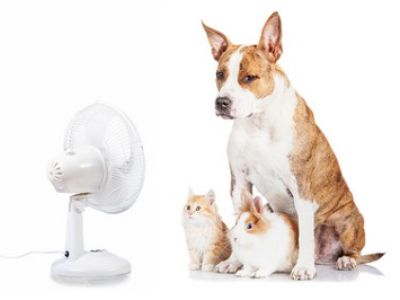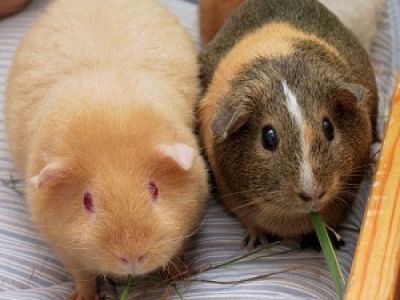Caring For Your Pet Rabbit

Rabbits are a very popular pet and are easy to look after. There are many different breeds of rabbits available. Small breeds such as the Dwarf or Dutch may look the right size for children to handle but are often rather feisty. Larger breeds including the New Zealand White and Flemish are naturally more docile; however, all can be tamed with regular gentle handling.
Handling
Rabbits have a relatively delicate skeleton, but comparatively strong muscles for running. As a result an improperly handled rabbit which kicks or struggles is at risk of fracturing its long bones or spine. Rabbits should never be picked up by the ears. Instead they should be grasped firmly by the scruff and have their hind limbs supported with the other hand. Never let their hind limbs dangle while being carried. Tucking their head under your arm gently while carrying them settles most rabbits down. It is also preferable to put the rabbit back in its hutch facing backwards; as many injuries occur when a rabbit tries to jump from a persons arms back into its hutch.
Housing
Rabbits can be housed in cages but should not be kept confined 24 hours a day. Many hutches sold for rabbits are too small; they should be at least 1.5 – 2 meters in length and high enough to allow the rabbit to stand up on their back legs. The hutch should have a shaded area at one end because rabbits are very susceptible to heat stress. Rabbits cannot tolerate temperatures above 28ْ C as they cannot sweat or pant effectively. It is advisable to cover the hutch in mosquito netting to minimize the chance of catching myxomatosis virus, which is spread by mosquitoes.
Many rabbits are kept together with guinea pigs. This is not recommended as rabbits are capable of spreading a bacteria called Bordetella bronchiseptica to guinea pigs. This organism has no effect on rabbits but causes severe disease and death in affected guinea pigs.
Cage floors should be either slatted wood or solid. Many of the cages sold have wire floors. This can cause injuries to rabbit feet which have no protective pads. If wire is the only flooring available then a resting board or rug should be provided to prevent foot problems. The floor can also be covered in a deep layer of straw which should be changed every 1 - 3 days. As straw can sometimes be a source of mites, shredded paper is a good bedding alternative if you have a problem with these parasites, though you may find that it will require replacing more often than straw.
Daily excursions into the backyard should be supervised to prevent problems with predators such as dogs and cats. You will also need to be careful that burrowing behavior does not make your pet inaccessible! Rabbits can be trained to hop in harness with gentle regular practice. Harnesses suited to rabbits can be specially ordered through any of our clinics.
Rabbits are also very easy to litter train so another alternative to a hutch is to keep them inside! You will need to rabbit-proof the house though because they will chew on anything! Bored rabbits may become destructive and will target sofas, carpets, electrical cords and many other items. Keeping a selection of boxes, baskets, toys and sticks (from fruit trees that have not been sprayed with insecticides) will help entertain your pet and prevent unwanted chewing. It should also be noted that excessive indoor heating can distress rabbits so it is important to give them access to a cooler section of the house if required.
Litter Training
Rabbits can be litter trained at any age. It is often easier to train a desexed rabbit as the hormones responsible for territorial marking are absent. Most rabbits will choose to eliminate in several areas (usually corners) so having a tray in the hutch as well as several spots around the house is advised.
The key to litter training your rabbit is to observe it closely and correct any unwanted behavior immediately. If the rabbit goes to the toilet anywhere else in its cage except in the litter box then the litter must be moved to that spot. If the rabbit eliminates in other spots in its surrounds apart from the litter trays provided then the rabbit should be reprimanded by saying “No.” and gently herding it to the appropriate area. Similar to other animals, rabbits will respond to food rewards for correct behavior.
A normal litter trained rabbit will drop small amounts of fecal pellets around their cage as a marking – this is not a failure of litter training.
In other instances, a previously litter trained rabbit may urinate in the wrong area due to health problems such as urinary tract infections or stress. It may be necessary to see a vet if this is suspected.
An important point to consider when choosing the litter for your rabbit is that rabbits will nibble at their litter. Hay is suitable material for a litter tray. Newspaper or recycled paper products can have poor odor control and may cause constipation if eaten by your rabbit. Wood shavings and sawdust are not suitable as many can cause liver problems if consumed. Clumping litters will also clump in the rabbit’s intestine causing problems.
Litter training is also beneficial as you are able to easily monitor the amount of faecal material that your rabbit is passing – a rabbit that is not pooing, is a very sick rabbit!
Diet
A rabbit’s diet should include a variety of vegetables, a good pelleted ration and access to fresh hay and grass. Fruit should only be given as a treat and should consist of no more than 28g per 2.5kg of bodyweight per day. It is recommended that there be a minimum of 18% fiber in the pellets provided, and that no more than 6 weeks supply is purchased at a time or it will spoil. Rabbits have a sweet tooth and will preferentially eat pellets sweetened with sugar or molasses. Obesity in rabbits is a common problem if allowed large volumes of sweet rations. This trait can be used to advantage if medication is to be given by mixing the medication with jam.
Hay is an essential dietary component and should be available every day. It provides roughage and prevents the formation of hairballs or other blockages. Vegetables should be offered but avoid beans and rhubarb. Lettuce should not be fed as it as a very poor nutrient content. Carrots are an important component of the diet because they help wear down the rabbit’s teeth which grow continuously throughout their lives! You can also offer a variety of dark leafy types such as broccoli or silver beet and root vegetables. Fiber is a very important part of a rabbit’s diet. To increase fiber in your rabbit’s diet provide unlimited grass hay, fresh fibrous veggies and limit his/her intake of commercial pellets.
Exercise also plays an important role in the prevention of digestive problems and obesity.
Initially for the first three weeks of life the rabbits drink the dam’s (mother’s) milk. After weaning you can introduce hay and pellets. Hay can be introduced from 7 weeks of age and vegetables from 12 weeks. At approximately 7 months of age they should be getting about ½ cup of pellets per 2.7kg bodyweight. From 1 – 5 years you can offer a larger variety of foods and decrease the pellets to ¼ cup per 2.7kg. A minimum of 2 cups of chopped veggies should be offered daily from one year of age.
Rabbits have a large requirement for water compared to many other animals. The average 2kg rabbit will daily drink as much as a 10kg dog. Rabbits not supplied with adequate amounts of water will actually stop eating and can die.
Preventative Medicine
Rabbits require vaccinations against calicivirus which is a fatal disease. They should generally be vaccinated at 10-12 weeks of age. If they are at high risk, a vaccination should be given earlier at 6-8 weeks, then repeated at 10-12 weeks. Annual vaccinations are then required for the rest of their life.
Unfortunately, in Australia a vaccine is not available for another serious disease of rabbits – myxomatosis. This is an incurable disease spread by mosquitoes. In order to try and prevent your bunny from contracting myxomatosis it is essential to reduce their exposure to mosquitoes.
There are several ways to do this;
1) Enclose your rabbit hutch/enclosure with mosquito-proof mesh/shade cloth
2) Speak to one of our Veterinarians about a monthly spot-on product (purchased only from veterinary clinics) that can be used to repel mosquitoes from your rabbit. We recommend the use of this product all year round. This product may also aid in the prevention of “flystrike” (see below.)
Many rabbits suffer from “malocclusion” which is upper and lower teeth that do not meet symmetrically. This leads to a condition called “slobbers” where the teeth (which grow continuously) do not wear down as they should and the rabbit is no longer able to eat. Rabbits suffering from this condition will drool and loose weight. Regular checking of the teeth is required to prevent problems. With the help of a general anesthetic, we are able to treat dental problems – malocclusion of the incisors can be trimmed with the dental drill and we are also able to burr spurs from the molars.
It is good practice to try and handle your rabbit everyday, whilst at the same time giving his coat and body a quick once over. Fly strike is a common problem that we treat; careful observation will ensure early detection of this problem. Rabbits with wet, matted or soiled backends are at particular risk. Make sure that your rabbit always has a clean, dry cage to reduce the occurrence of fly strike.
Rabbits, unlike dogs and cats do not require worming on a regular basis. Many of the worms which cause problems in rabbits are not present in Australia.
Long haired rabbit breeds such as the Himalayan require regular grooming, because their long, fine hair has a tendency to form knots easily. These breeds are often shaved shorter during the warm weather – grooming brushes can be ordered through any of our clinics and a grooming service is available at our Greensborough branch. Rabbit’s nails also have a tendency to grow rapidly and require regular clipping.
Desexing
Female and Male rabbits reach puberty from three months (smaller breeds) to eight months (larger breeds) of age. Therefore males and females should be separated from 10 weeks of age. It is preferable to desex rabbits at approximately 6 months of age.
There are many reasons to desex your rabbit including:
- It is the most effective way of reducing the risk of ovarian, uterine and mammary cancers, which female rabbits are highly prone to developing.
- Desexing diminishes hormonally based aggression especially between entire male rabbits.
- Desexing creates calmer rabbits that are less prone to frustrated, destructive behaviours.
- Desexing prevents overpopulation.
- Desexing makes litter training easier.
- Desexing reduces obnoxious behaviours such as urine spraying.
Reproduction
The age at which rabbits attain sexual maturity varies according to breed; however most are able to reproduce from 4 – 8 months of age.
Similar to cats and ferrets, rabbits are induced ovulators. This means they do not have an oestrus cycle and lack obvious external signs of receptivity to mating. To determine when best to breed rabbits, owners must observe the female for signs of ‘lordosis’, or reverse arching of the back, when she is approached by the male. Some rabbits may show signs of a red or purple vulva when ready to mate but this is not a consistent finding. Rabbits may mate throughout the year but are most active during spring.
It should be noted that transportation of a female rabbit may result in ovulation, so it is best to bring the male to the female. Ovulation without mating may result in a “phantom pregnancy “ which lasts for approximately 18 days in which the female acts as if pregnant (making nests and some even produce milk) but is not.
Gestation length ranges from 30 to 33 days with most does giving birth (called kindling) in the early morning. Many does will pull fur from their abdomen to make a nest several days to hours before giving birth. Litter size varies from 4 – 12 kits, depending on age and breed. Kits are born blind, hairless and helpless and remain in the nest for 3 weeks. Unlike most animals does only nurse the kits once daily for 3 – 5 minutes so it is very important not to disturb them while they are feeding.
Orphaned rabbits can be fed specific rabbit milk replacer (preferably), or else a general kitten or puppy milk replacer. They should feed one to three times daily and consume up to 20% of their body weight during this feeding period. Begin by feeding approximately 5ml per feed then gradually increase over several days to 25ml per feed. It is important to weigh hand reared rabbits every day. If they are not gaining weight daily then seek advice from your vet.
![]() Caring For Your Pet Rabbit PDF267.21 KB
Caring For Your Pet Rabbit PDF267.21 KB



